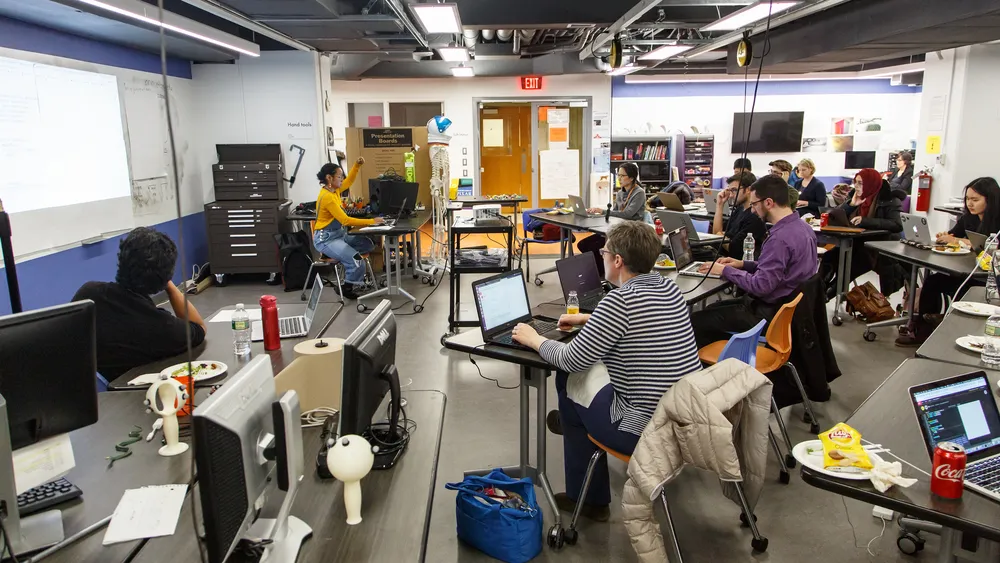CDH and CST Collaborate as They Play with Data!
18 March 2019
Play is not just for kids. It can benefit scholars, too.

As part of the ongoing “Year of Data” initiative, the Center for Digital Humanities (CDH) and The Council on Science and Technology (CST) together opened their doors to non-programmers for a two-part “Playing with Data” workshop. “We wanted to give beginners a safe space to experiment with data, free to make mistakes and just ‘play’ allowing them to get comfortable working with data on a small scale,” explained Rebecca Koeser, CDH’s Lead Developer and one of the organizers. Unlike prior workshops that required technical expertise, like the Hackathon held in January, the “Playing with Data” workshops introduced beginners to “creative coding,” or computer programming that is creative and expressive, using the p5.js web editor, a JavaScript-based program with a “sketchbook” framework aimed at artists, designers and beginners.
Aatish Bhatia (Associate Director, CST Engineering Education) and Sharon De La Cruz (Assistant Director, CST StudioLab Initiatives) led the workshops, seamlessly taking turns and passing the teaching “baton” between each other as they walked participants through the capabilities of the p5.js web editor. With different areas of expertise - Aatish’s background is in the fields of physics, bioinformatics, physics and engineering education, and science communication and Sharon’s experience is in the fine arts - each shared their perspectives on how best to achieve visualizations “beyond the (standard) line graph,” as Sharon noted.
Workshop organizers were inspired by an earlier Year of Data symposium on Intersectional Data where guest speaker Lauren Klein challenged representing data with conventional “objective” bar charts and encouraged more evocative, emotional interaction with data by asking “why shouldn’t a visualization evoke emotion?” Similarly, Bhatia and De La Cruz encouraged people to think more creatively about the range of ways we can represent and interact with data, rather than always using the same familiar tools and approaches to data visualization.
For the first workshop, everyone gathered in the glass-enclosed open space of CDH on Firestone’s B-level to learn the basics of the p5.js web editor tool. By the end, they had all produced their very own sketches, amusingly referred to as robot chickens .
Four "robot chicken" self-portraits created by participants and shared with the group in the first session. Shared with permission.
“Aatish and Sharon are such great instructors. Time literally flew by! (chicken pun intended)” joked Nora Benedict, a Weld Postdoctoral Fellow. At the second workshop a week later, the group met deep in the basement of the Fine Building in the CST Studio Lab - a lab geared towards connecting art and humanities with technology, and designed to encourage experimentation, learning, and teaching others.
Between the workshops and beyond the classrooms, creative thinking and collaboration between CDH and CST continued as the development team worked together on collecting simple datasets from Princeton University Library (PUL) and CDH-sponsored projects for people to “play” with in the second workshop. They also curated “data viz” compilations much like many of us put together playlists. These data visualizations were shared and discussed in this second workshop, which recapped the first session and worked towards a visualization based on a “warming stripes” climate change visualization data. “Seeing real-world examples really helped to see the potential of this visualization tool,” said Wafa Isfahani, a Princeton graduate student in Near Eastern Studies. This workshop series was one of many collaborations between CDH and their campus partners who helped co-sponsor the Year of Data (YODA) with the mission to encourage critical thinking about how data shapes our research, teaching, and daily lives.
Next up for YODA is a conference entitled Building Bridges with Data , where humanities scholars and librarians from across continents will address the question: “How do we build transcontinental bridges across cultures and institutions through a shared interest in archival data?”
